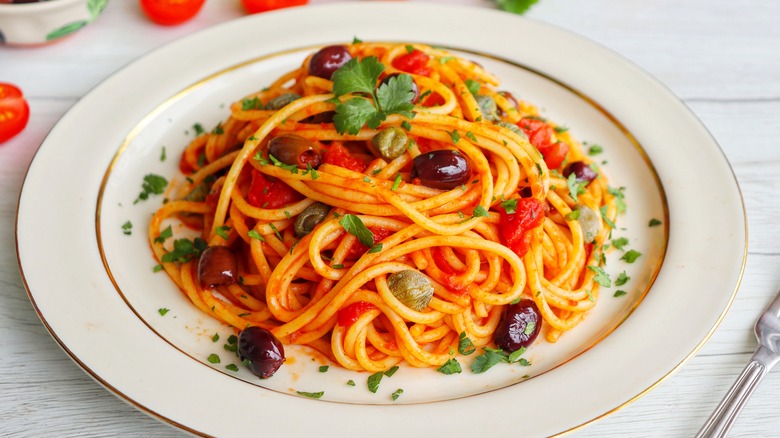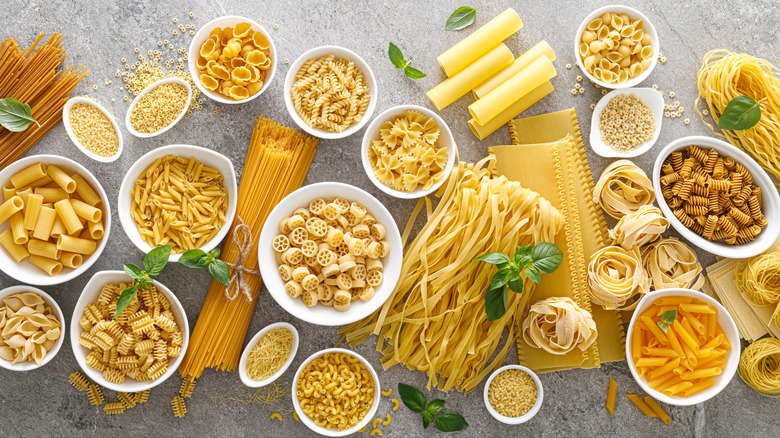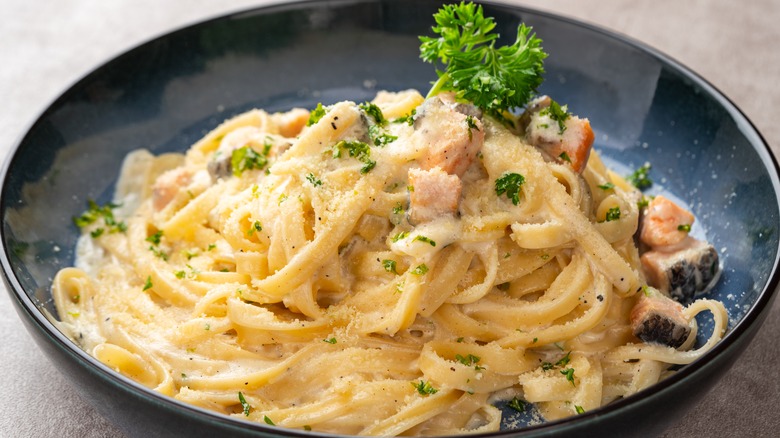Spaghetti Vs. Linguine Vs. Fettuccine: Are They Interchangeable?
When it comes to Italian cuisine, pasta takes center stage. From angel hair to pappardelle, plenty of restaurants offer a plethora of options to order from. Then, there are all of the savory sauces, brimming with meats, cream, and vegetables. Each pasta dish provides its own unique experience, satisfying your taste buds with every mouthful.
While restaurants bring pasta to impressive life, your own pantry may very well be stocked with more types of noodles than even the fanciest joint boasts. Spaghetti, linguine, and fettuccine are particular stand-outs, offering tremendous flexibility when cooking up delicious pasta-centric meals. Whether you prefer lightly drizzling your noodles with oil and cheese or bathing them in a rich, meaty sauce, these shapes do the job. They share many remarkable similarities, but are they interchangeable? The answer is no. Their differences are, in fact, pretty important, especially if you want to take your pasta to the next level. Let's dig in.
You can swap certain noodles
Every pasta shape has its own particular purpose. Spaghetti's medium-thin size makes it ideal for cooking with a variety of sauces. You can't go wrong with a hearty dish of spaghetti and meatballs, of course. Creamy sauces like carbonara also blend seamlessly with these circular noodles. If you're looking for thick, long, strands in your dish, however, fettuccine — aka "little ribbons" — is the noodle for you. This variety of pasta works well with classic alfredo sauce, as the wide shape perfectly soaks up such heavy, dairy-rich goodness. Linguine fits right in between spaghetti and fettuccine, as it's somewhat flat and thin. This allows it to adapt to a range of ingredients, allowing you to create everything from linguine with garlic and oil to linguine with clams.
Basically, spaghetti, linguine, and fettuccine are interchangeable, but only to a certain degree. Linguine is the most versatile, as it's smack in the middle between the two outlying shapes. If you've run out of fettuccine and you're making a simple garlic sauce, linguine will do the trick. However, the difference between spaghetti and fettuccine is significantly more vast. If, say, you're making fettuccine alfredo and you run out of noodles, spaghetti won't work all that well as a substitute.
Getting creative with pasta substitutions
So, you can't easily swap fettucine for spaghetti. But that doesn't mean you can't get creative with these shapes in other ways, or that there aren't a wide variety of sauces that suit all of them. Consider cacio e pepe. This silky sauce, which combines cheese and black pepper, is a beloved classic. It suits spaghetti, fettuccine, and linguine, as well as a wide variety of other shapes, like rigatoni and penne. Spaghetti and linguine do a great job of tangling up the sauce's distinct flavor notes, while fettuccine soaks up the creaminess of the sauce. By experimenting with all three shapes, you can bring new facets of the sauce to light.
Carbonara is another great option for all three shapes. While it's traditionally made with spaghetti, fettuccine suits its richness wonderfully: Each ribbon-like noodle becomes a luxurious river of flavor. Linguine strikes a nice balance between it and classic spaghetti, if you'd like to bump up the decadence but still benefit from a thinner shape's ingredient-capturing potential. Not sure which one you'll like best? You'll just have to cook them all to find out.


